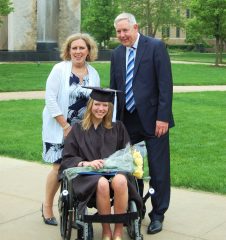Participation in Friedreich’s Ataxia Clinical Trial: Joanna’s Story

Whether or not to participate in a clinical trial is a hard decision to make — but when it comes to deciding for a child, the task can be the hardest of a lifetime.
When Sandra Sojka Lagedrost’s daughter Joanna was only 10 years old and diagnosed with Friedreich’s ataxia (FA) questions came almost daily about whether or not the mother’s choses were always correct.
“You’re always asking yourself, ‘Are we covering all the bases? Have we looked everywhere?’ You are so responsible because it is someone else. You’re very conscious of the fact that this is on behalf of your child,”Lagedrost said, in a story on The Center for Information and Study on Clinical Research Participation (CICCRP).
But Sandra remembers when she and her husband John had an opportunity to enroll Joanna in a Phase III clinical study at the Children’s Hospital of Philadelphia. But, because there are no current treatments for FA, they were not left with many options – except the trial treatment. The answer was indeed, yes.
Joanna began stumbling and falling when she was in fourth grade. The pediatrician recommended a neurologist and the diagnosis came soon after.
Life went on for the family as normal as possible, considering typical childhood activities peppered with physical therapy dates — and the couple added their daughter to a disease registry.
When they learned about the double-blind, placebo-controlled trial in Philadelphia, Joanna was already 14. Her mobility and coordination were deteriorating, and she tired easily.
The process wasn’t easy. Treatment required Sandra and Joanna to travel twice monthly from Chicago to Philadelphia for 18 months. But the research team’s accommodating and compassionate demeanor made it easier.
“It was a very good experience,” Sandra said in the CICCRP story. “Although we signed the informed consent forms, they explained everything very clearly and in an age-appropriate way to her. Every time there was even the slightest change in protocol they talked to us about it, and we would have to sign our consent forms all over again. They were really by the book, and I found that reassuring.”
Unfortunately for Joanna, the treatment did not work. But Joanna participated in a second natural history study in Philadelphia, to help researchers better understand FA.
Soon, she began making her own decisions and decided to focus more as a student at the University of Notre Dame.
“When she turned 18 there was a piece of me that was relieved that she was a legal adult and that I could hand off the decision-making and recognize her insights. It wasn’t mom and dad any more saying, ‘You have to do this’,” Sandra said referring to when she began stepping into a more advisory role. “In some ways nothing changed, but in some ways a lot did.”
Now 22, Joanna is an intern in a law firm and a freelance editor. She participated in heart studies in Indianapolis and New York — FA mostly affects mobility but it can lead to heart disease. Joanna says she is acutely aware of how much work goes into finding, pursuing and participating in clinical trials but she knows that trials are worth it because they are critical for finding a cure.
“Human beings like attention,” Joanna said. “When you consider the fact that someone is paying enough attention and money to put on a clinical trial to focus on your condition, it’s hard to understand how someone would not want to participate. It’s obviously for a very good long-term cause and you may enjoy positive outcomes too.”






